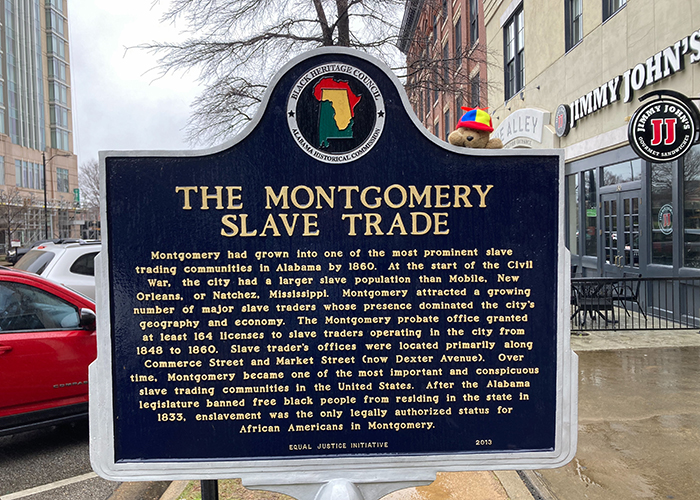
Plaque Text for this Alabama landmark:
Montgomery had grown into one of the most prominent slave trading communities in Alabama by 1860. At the start of the Civil War, the city had a larger slave population than Mobile, New Orleans, or Natchez, Mississippi. Montgomery attracted a growing number of major slave traders whose presence dominated the city’s geography and economy. The Montgomery probate office granted at least 164 licenses to slave traders operating in the city from 1848 to 1860. Slave trader’s offices were located primarily along Commerce Street and Market Street (now Dexter Avenue). Over time, Montgomery became one of the most important and conspicuous slave trading communities in the United States. After the Alabama legislature banned free Black people from residing in the state in 1833, enslavement was the only legally authorized status for African Americans in Montgomery.
More about The Montgomery Slave Trade:
After crossing the Atlantic, chained together in the dark in their own waste, enslaved folks arrived in Montgomery by road, by rail, and by river. There were four depots, two pens, and a large market, run by such mundane sounding names as Mason Harwell, John Murphy, S.N. Brown, Thomas Frazer, and E. Barnard & Co. Their advertisements for enslaved folks ran alongside home furnishings in the local newspapers.
How Can I #HelpTheHelpers?
- Become a member of the Alabama Historical Association!
- Donate to the Equal Justice Initiative (EJI)!
- Be a responsible visitor! Please respect the signs and pathways, and treat all structures and artifacts with respect. They’ve endured a lot to survive into the present. They’ll need our help to make it into the future!
How Do I Get There?
118 Commerce St
Montgomery, AL 36104
(Take Me There!)
When Should I Visit?
Whenever the mood strikes you!
